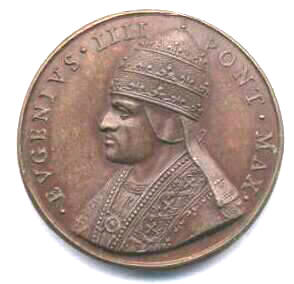 Gabriele
Condulmer was born in 1338 of a noble and wealthy Venetian
family. He gave away his wealth and joined the canons regular of
St. Augustine. His uncle, Pope Gregory XII made him a cardinal
in 1408. He remained loyal to his uncle at the time of Pisa, and
went to Constance only after Gregory's abdication. He was
elected pope on the first ballot and took the name Eugene IV.
Gabriele
Condulmer was born in 1338 of a noble and wealthy Venetian
family. He gave away his wealth and joined the canons regular of
St. Augustine. His uncle, Pope Gregory XII made him a cardinal
in 1408. He remained loyal to his uncle at the time of Pisa, and
went to Constance only after Gregory's abdication. He was
elected pope on the first ballot and took the name Eugene IV.
Tall, thin, austere, Eugene's very presence inspired
reverence. Generous and religious, he made an amiable pope. He
had something to learn about diplomacy and did improve as he
grew older. He had agreed to an election capitulation which gave
the cardinals more power than they deserved. He took harsh
measures against the family of Martin V, but the powerful
Colonna fought back so furiously that it took the aid of
Florence, Venice, and Naples to beat them down to terms. A
revolution broke out in Rome which sent Eugene flying to
Florence, but soon the papal government was re- established.
Eugene's greatest problem was the council that Martin had
convoked at Basel in Switzerland. The council got out of hand
and by a series of revolutionary decrees tried to make a limited
monarchy out of the papacy. For a while the situation was dark,
but fear of another schism so frightened the best men that when
the Pope moved the council to Ferrara, the leaders all obeyed.
One cardinal, a few bishops, and a rabble of theologians defied
the Pope to remain at Basel and go from absurdity to worse. This
rump council deposed Eugene and elected an antipope, Amadeus of
Savoy, who took the name Felix V. For a short time this
pocket-size schism had some support, but meanwhile great things
were in the making at Ferrara and Florence where the council
moved in 1439.
The Eastern emperor, John VII, eager for Western help against
the Turks, led an imposing array of dignitaries to the council
at Ferrara to seek reunion with Rome. At Florence the union was
solemnly proclaimed. There was great rejoicing that the Eastern
Schism was now healed, but the union, though accepted sincerely
by men like Bessarion and Isidore of Kiev, was not popular at
Constantinople and lasted only until the fall of the Empire in
1453.
To the council also came an Armenian delegation to renounce
the Monophysite heresy and return to Catholic unity. Copts and
Abyssinians soon joined the Armenians. These unions, though
short-lived, were important, because since Florence there had
been at least small groups which stayed faithful to Rome. These
are called Uniates. At Basel also the Hussites of Bohemia,
having soundly trounced crusading armies, became freely
reconciled to the Church. The results of this
Basel-Ferrara-Florence Council are highly significant. The
excesses of the rebellious Basel group struck a blow at the
conciliar theory while the return of the Eastern Churches to
unity enhanced the prestige of the papacy.
Eugene did try to reform the Church, but he was preoccupied
with the council. He did encourage St. Frances of Rome in her
noble work. He himself gave good example by his piety and
charity. He tried to get a crusade under way against the Turks,
but it was drowned in blood at Varna. He did succeed in
negotiating a concordat with the Byzantine Empire.
Now the Renaissance was blooming, and the Pope did his part
to encourage art. He ordered the bronze gates which still stand
at the entrance to St. Peter's. He also commissioned the famous
Fra Angelico to decorate a new chapel in the Vatican.
Eugene IV died February 23, 1431. He had guided the Church
through a tempestuous time.
Excerpted from "Popes
Through the Ages" by Joseph Brusher, S.J.

